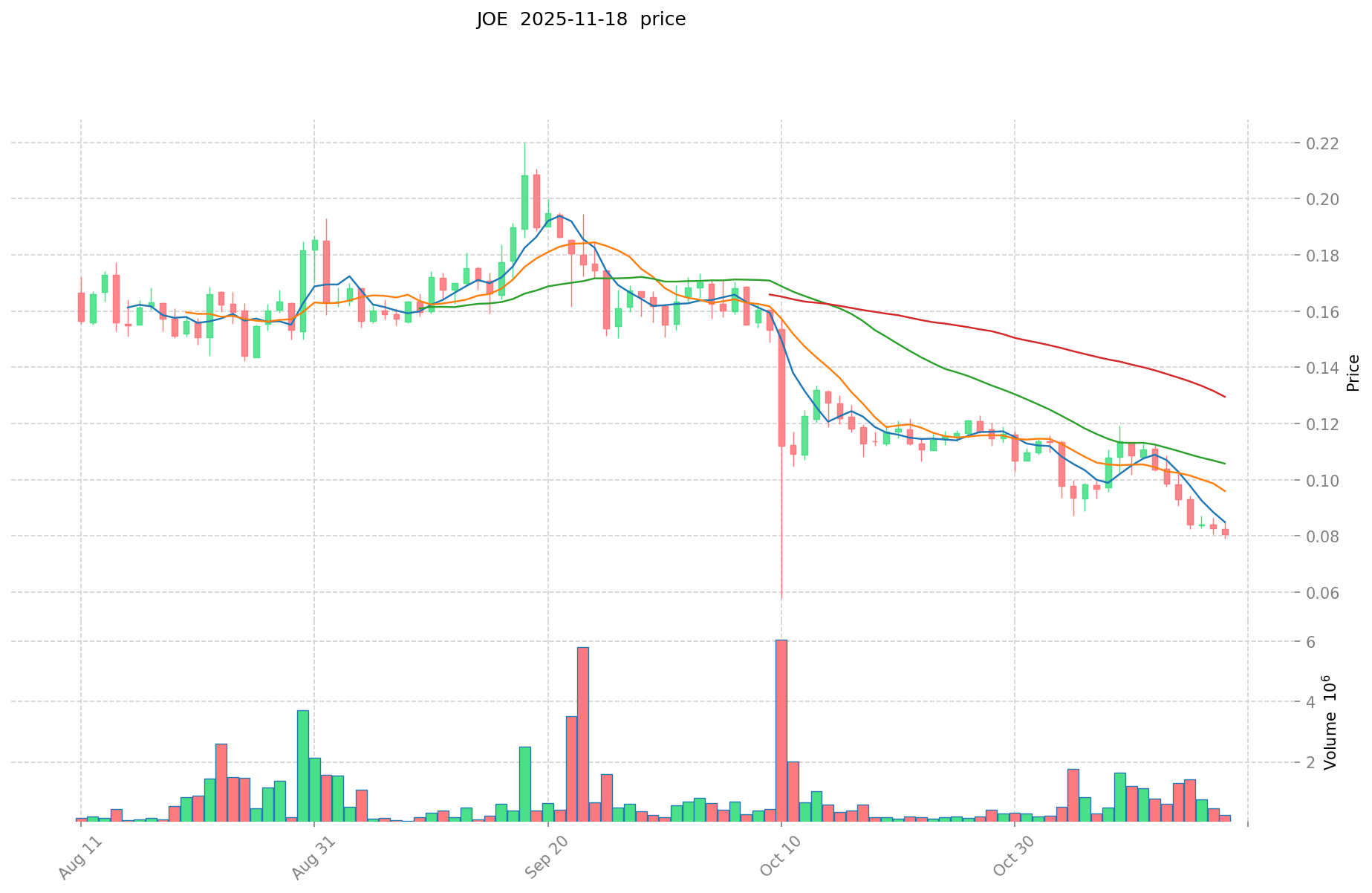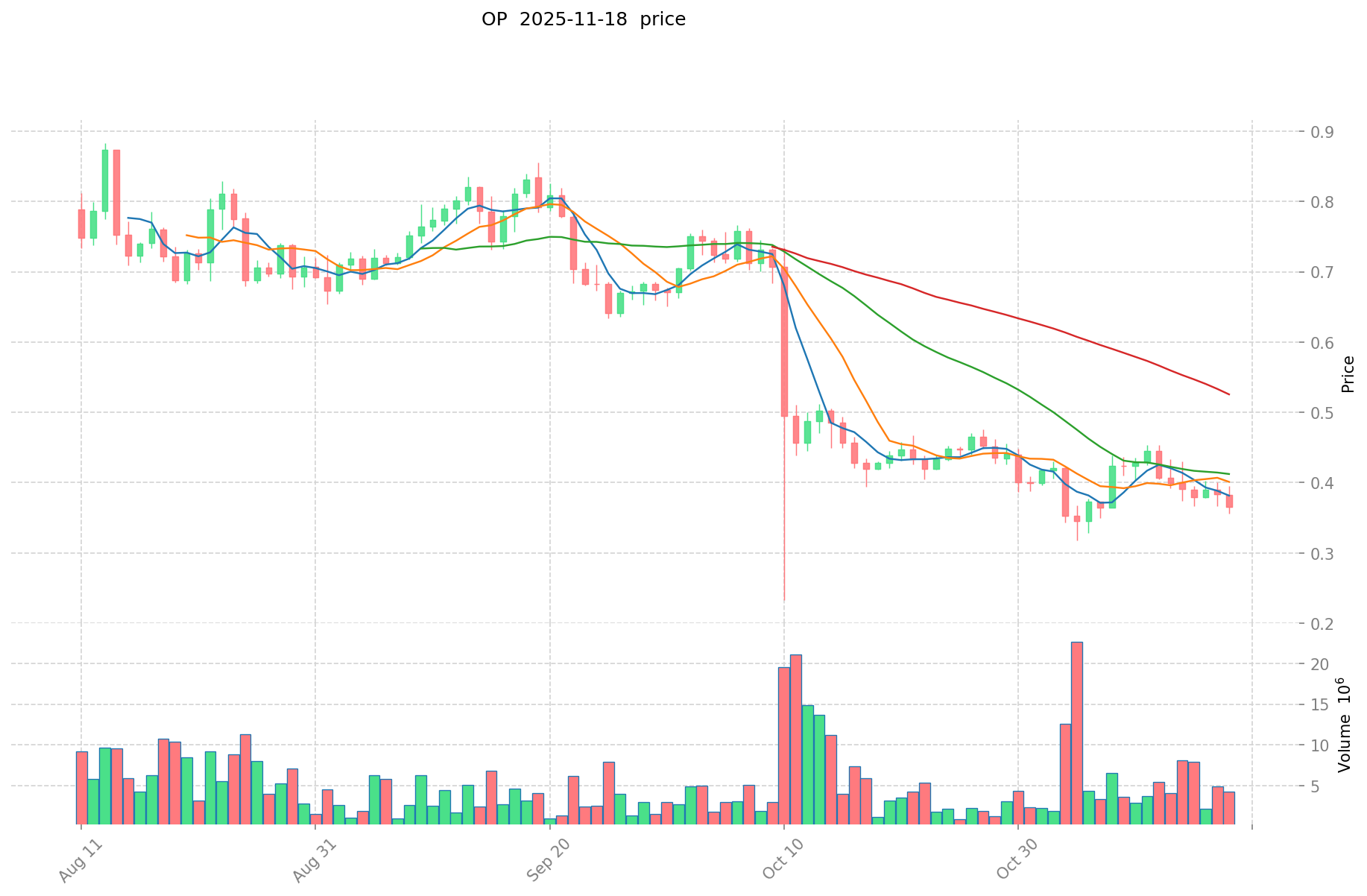JOE vs OP: The Ultimate Showdown in Competitive Gaming
Introduction: JOE vs OP Investment Comparison
In the cryptocurrency market, the comparison between JOE and OP has always been a topic that investors can't avoid. The two not only have significant differences in market cap ranking, application scenarios, and price performance, but also represent different crypto asset positioning.
JOE (JOE): Since its launch, it has gained market recognition for its role as a governance token on the Trader Joe platform, a one-stop decentralized trading platform on the Avalanche network.
OP (OP): Launched as the native governance token for Optimism, it has been hailed as a solution for Ethereum's scaling issues, representing one of the leading layer-2 scaling solutions.
This article will comprehensively analyze the investment value comparison between JOE and OP, focusing on historical price trends, supply mechanisms, institutional adoption, technological ecosystems, and future predictions, attempting to answer the question that investors are most concerned about:
"Which is the better buy right now?"
I. Price History Comparison and Current Market Status
JOE and OP Historical Price Trends
- 2021: JOE reached its all-time high of $5.09 due to the DeFi boom.
- 2024: OP hit its peak price of $4.84 in March, likely influenced by Ethereum Layer 2 adoption.
- Comparative analysis: During the recent market cycle, JOE dropped from its high of $5.09 to a low of $0.02658814, while OP fell from $4.84 to $0.322746.
Current Market Situation (2025-11-19)
- JOE current price: $0.08013
- OP current price: $0.3824
- 24-hour trading volume: JOE $36,363,902 vs OP $1,776,297,788
- Market Sentiment Index (Fear & Greed Index): 11 (Extreme Fear)
Click to view real-time prices:
- Check JOE current price Market Price
- Check OP current price Market Price


Investment Value Analysis: JOE vs OP
Core Investment Factors
- Trader Joe: The core advantage lies in its resilient team with strong delivery capability and innovation. Good product experience and liquidity orderbook innovation have driven rapid user growth.
- OP (Optimism): Investments in OP often rely primarily on speculative value, with potential to drop to zero if unable to find subsequent buyers.
Team and Innovation Comparison
- Trader Joe Team: Demonstrates tenacity, excellent delivery capability, and continuous innovation in DeFi products
- Market Innovation: Trader Joe's orderbook liquidity innovations have significantly improved trading experience and reduced friction costs
- Capital Efficiency: The design philosophy focuses on reducing transaction costs and improving capital utilization for traders
Liquidity and Economic Models
- Trading Experience: Trader Joe offers lower fees, faster execution speeds, and greater flexibility compared to competitors
- Value Capture: While OP faces challenges in value capture mechanisms, Trader Joe has created sustainable economic incentives
- User Growth: Trader Joe's innovations have directly translated to measurable user growth metrics
Market Position and Future Outlook
- Ecosystem Integration: Trader Joe has positioned itself well within the Arbitrum ecosystem
- Institutional Appeal: Professional investors appreciate Trader Joe's objective, data-driven approach to platform development
- Long-term Sustainability: Trader Joe's model appears more focused on creating lasting value versus purely speculative gains
III. 2025-2030 Price Prediction: JOE vs OP
Short-term Prediction (2025)
- JOE: Conservative $0.0409 - $0.0803 | Optimistic $0.0803 - $0.0916
- OP: Conservative $0.2294 - $0.3824 | Optimistic $0.3824 - $0.3939
Mid-term Prediction (2027)
- JOE may enter a growth phase, with expected prices $0.1002 - $0.1301
- OP may enter a consolidation phase, with expected prices $0.2575 - $0.5108
- Key drivers: Institutional capital inflow, ETFs, ecosystem development
Long-term Prediction (2030)
- JOE: Base scenario $0.1747 - $0.2411 | Optimistic scenario $0.2411 - $0.2411
- OP: Base scenario $0.7120 - $0.8188 | Optimistic scenario $0.8188 - $0.8188
Disclaimer
JOE:
| 年份 | 预测最高价 | 预测平均价格 | 预测最低价 | 涨跌幅 |
|---|---|---|---|---|
| 2025 | 0.091599 | 0.08035 | 0.0409785 | 0 |
| 2026 | 0.12724226 | 0.0859745 | 0.05674317 | 7 |
| 2027 | 0.1300622236 | 0.10660838 | 0.1002118772 | 33 |
| 2028 | 0.170402834592 | 0.1183353018 | 0.113601889728 | 47 |
| 2029 | 0.20500407683832 | 0.144369068196 | 0.13137585205836 | 80 |
| 2030 | 0.24106747007368 | 0.17468657251716 | 0.148483586639586 | 118 |
OP:
| 年份 | 预测最高价 | 预测平均价格 | 预测最低价 | 涨跌幅 |
|---|---|---|---|---|
| 2025 | 0.393872 | 0.3824 | 0.22944 | 0 |
| 2026 | 0.44247504 | 0.388136 | 0.35320376 | 1 |
| 2027 | 0.5108257896 | 0.41530552 | 0.2574894224 | 8 |
| 2028 | 0.689967825652 | 0.4630656548 | 0.435281715512 | 21 |
| 2029 | 0.84747960813222 | 0.576516740226 | 0.3170842071243 | 50 |
| 2030 | 0.818797900305976 | 0.71199817417911 | 0.498398721925377 | 86 |
IV. Investment Strategy Comparison: JOE vs OP
Long-term vs Short-term Investment Strategies
- JOE: Suitable for investors focused on DeFi ecosystem potential and innovative trading platforms
- OP: Suitable for investors interested in Ethereum scaling solutions and Layer 2 technologies
Risk Management and Asset Allocation
- Conservative investors: JOE: 30% vs OP: 70%
- Aggressive investors: JOE: 60% vs OP: 40%
- Hedging tools: Stablecoin allocation, options, cross-currency portfolios
V. Potential Risk Comparison
Market Risk
- JOE: Highly dependent on DeFi market trends and Avalanche ecosystem growth
- OP: Tied to Ethereum's success and adoption of Layer 2 solutions
Technical Risk
- JOE: Platform security, smart contract vulnerabilities
- OP: Scalability issues, network stability
Regulatory Risk
- Global regulatory policies may impact both tokens differently, with DeFi platforms potentially facing more scrutiny
VI. Conclusion: Which Is the Better Buy?
📌 Investment Value Summary:
- JOE advantages: Strong team innovation, improved trading experience, sustainable economic model
- OP advantages: Ethereum scaling solution, potential for widespread Layer 2 adoption
✅ Investment Advice:
- New investors: Consider a balanced approach, leaning towards OP for its connection to Ethereum ecosystem
- Experienced investors: Explore JOE for its innovative DeFi features while maintaining exposure to OP
- Institutional investors: Evaluate JOE's long-term sustainability and OP's role in Ethereum scaling
⚠️ Risk Warning: The cryptocurrency market is highly volatile. This article does not constitute investment advice. None
VII. FAQ
Q1: What are the main differences between JOE and OP? A: JOE is a governance token for Trader Joe, a decentralized trading platform on Avalanche, while OP is the native token for Optimism, an Ethereum Layer 2 scaling solution. JOE focuses on DeFi innovations, while OP aims to improve Ethereum's scalability.
Q2: Which token has performed better historically? A: OP has shown better price performance recently. In 2024, OP reached its all-time high of $4.84, while JOE's all-time high was $5.09 in 2021. As of 2025-11-19, OP is trading at $0.3824, higher than JOE's $0.08013.
Q3: What are the key investment factors for each token? A: For JOE, key factors include the team's innovation capability, improved trading experience, and sustainable economic model. For OP, the main factors are its role in Ethereum scaling and potential widespread Layer 2 adoption.
Q4: How do their future price predictions compare? A: By 2030, JOE is predicted to reach $0.1747 - $0.2411 in the base scenario, while OP is expected to reach $0.7120 - $0.8188. OP generally shows higher price predictions in the long term.
Q5: What are the main risks associated with investing in JOE and OP? A: Both face market risks tied to their respective ecosystems. JOE is exposed to DeFi market trends and Avalanche ecosystem growth, while OP is linked to Ethereum's success. Technical risks include platform security for JOE and scalability issues for OP. Both may face regulatory risks, with DeFi platforms potentially under more scrutiny.
Q6: How should investors allocate their assets between JOE and OP? A: Conservative investors might consider allocating 30% to JOE and 70% to OP, while aggressive investors could opt for 60% JOE and 40% OP. The exact allocation should be based on individual risk tolerance and investment goals.
Q7: Which token is considered the better buy overall? A: The better buy depends on the investor's profile. New investors might lean towards OP due to its connection to the Ethereum ecosystem. Experienced investors could explore JOE for its innovative DeFi features while maintaining exposure to OP. Institutional investors should evaluate JOE's long-term sustainability and OP's role in Ethereum scaling.
Share
Content